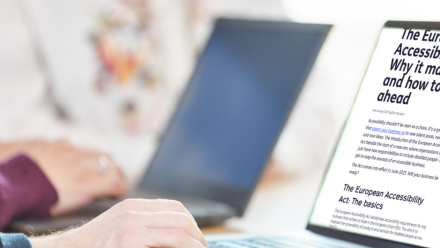Support for disabled workers is out there, so why aren’t we accessing it?
17th April 2020 by Ellie Thompson
By Jo Faragher for D&I Leaders
If the Covid-19 situation has taught us anything, it’s that accessibility needs to be at the top of every organisation’s agenda. IT and HR teams have faced a frenetic few weeks ensuring that employees’ home environments meet all of the needs of a diverse group of workers.
Atif Choudhury, co-founder and director of Diversity & Ability, a social enterprise that promotes inclusion for neurodiverse people/disabled people, says that, in the current situation, “some of those who have been marginalised physically are leading the way”. So teams that are used to making technology adjustments for physical disabilities or offering support with virtual working for those on the autistic spectrum for example, are now coming into their own. Thanks to the unprecedented situation we find ourselves in, employers are having to get their acts together quickly on inclusion and accessibility.
But this has not always been the case. The disability employment gap is 36%, according to the Office for National Statistics – the latest comparative figures show that just over half of disabled people (53.2%) were in employment, compared to 81.8% of non-disabled people. Yet take up of Access to Work (ATW) grants, which offer financial support to employers to recruit and keep disabled people in work is woefully low. From 1 April this year, organisations can apply for the grants up to a cap of £60,700 per year per employee to fund, for example, a British Sign Language interpreter or specialist equipment.
Disclosure
One of the issues impeding take-up of ATW is disclosure. “People have applied for the Disabled Students’ Allowance in their 1000s but are then not applying for ATW when they go into jobs – has their disability disappeared?” asks Choudhury. Where they do not feel their workplace is inclusive, or that they risk being discriminated against because they choose not to hide a disability, thousands of employees are missing out on support available. He adds: “Most companies act as though the Disability Discrimination Act (now repealed and replaced by the Equality Act 2010) is what governs them. If reasonable adjustments are your first port of call, are we truly welcoming diversity of thought and people into our organisations? Compliance means they don’t get sued but doesn’t mean they include. The end result is that they often don’t hire these people in the first place to play safe.”
“If employees are not disclosing, they’re doing their best to fit in, turning down promotions in case they get found out – they think ‘why apply for Access to Work?’” says Choudhury. Yet the Equality Act 2010 requires employers to anticipate whether someone needs support and to put it in place, that organisations assume employees may come under one of the protected characteristics rather than waiting for them to tell them about it. This is why a culture where disclosure feels safe is so important, he adds. As a small organisation, Diversity & Ability has an 85% disclosure rate and makes full use of the government grants available to it – but this is not the case for every SME or even many major corporates. “I have a director who has cerebral palsy, and without ATW I’d be paying for his PA every time he needs to travel for work. ATW says this is fair, that the person is an asset and needs support,” he says.
What will it take?
Choudhury argues that it took a certain level of public shame to shift the dial around gender pay – for big organisations such as the BBC and FTSE 100 companies to have their gender pay differences scrutinised in the press. “Do we wait until it reaches this point with disability or do we do something right now? Businesses need to look at the strengths of employing people with disabilities, the arguments for employing them.” Being reactive, for example only making adjustments when you feel you ‘have’ to because of the law, will not change the disability employment gap.
If organisations fail to promote inclusive cultures where disclosure is high and employees feel comfortable in their difference, take-up of grants such as this may be lost. “If these support mechanisms aren’t used, will they be around forever?” he asks. “The most disabling things on earth are attitudes. If we want to shift the disability employment gap, do we wait until it’s public shame or do it because it’s the right thing to do? ”


